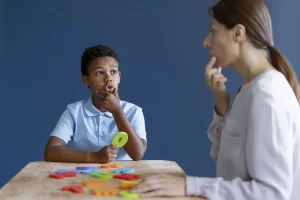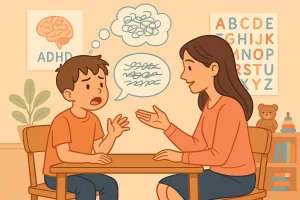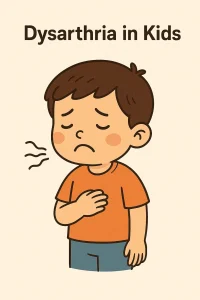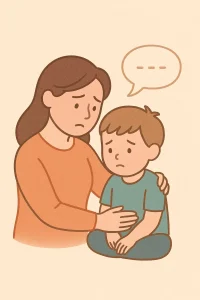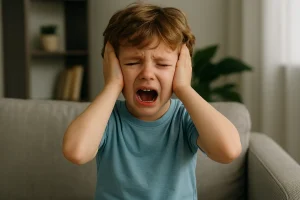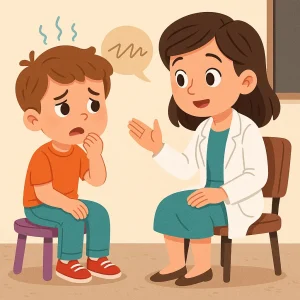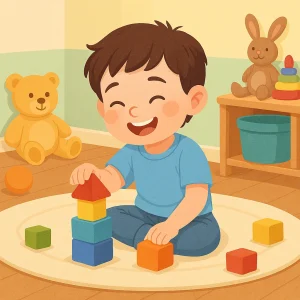Do Toddlers With Autism Babble Like Others?
By Rajini D
Last Updated: July 31, 2024
Autism, or Autism Spectrum Disorder (ASD), is a neurodevelopmental condition that affects how a person interacts, behaves, communicates, and learns. Children with autism often experience developmental delays in three key domains: behavior, learning, and social interactions. Understanding how autism impacts child development, especially in the early years, is crucial for parents, caregivers, and educators.
Babbling is one of the earliest forms of vocalization and is a significant milestone in a child’s speech development. Typically, infants start producing repetitive sounds like ‘dada’ or ‘mama’ around 10 months of age, known as canonical babbling. However, for toddlers with autism, this developmental milestone may be delayed or appear differently compared to neurotypical children.
Recognizing and understanding babbling patterns in toddlers with autism can help parents and professionals identify early signs of autism. By doing so, it becomes possible to intervene early and provide the necessary support for the child’s speech and language development.
Understanding Babbling in Toddlers with Autism
What is Babbling?
Babbling is an essential developmental milestone that represents a child’s early vocalizations, usually starting around 6 months of age. This phase allows babies to practice the motor movements required for speech, and it’s a stepping stone toward meaningful language. Canonical babbling refers to repetitive sounds like ‘dada’ and ‘mama.’ The rhythmic repetition of syllables helps infants fine-tune their oral motor skills, making babbling crucial in speech development.
Importance of Babbling as a Critical Milestone in Speech Development
Babbling is a sign that a child is developing the foundational skills necessary for future speech and language acquisition. During this stage, infants experiment with their vocal cords and gradually refine their ability to produce more complex sounds. By 10 months, typically developing infants engage in canonical babbling, a key indicator that they are on the path to developing their first words.
Babbling Patterns in Toddlers with Autism
For toddlers with autism, babbling patterns can look different from those of neurotypical children. Research indicates that babbling is often reduced or delayed in toddlers with autism spectrum disorder (ASD). Here’s how babbling patterns in children with autism differ:
- Delayed Onset: Some children with ASD start canonical babbling much later than the usual 10-month mark.
- Reduced Frequency: Even if a toddler with autism begins babbling, it may occur less frequently than in neurotypical peers.
- Lack of Social Engagement: While neurotypical toddlers often babble in response to social interaction, children with autism may not babble socially.
- Jargon Usage: Some toddlers with autism may produce long strings of nonsensical speech sounds, known as jargon. Jargon is often repetitive and may not be directed toward another person.
Reduced or Delayed Babbling as an Early Sign of Autism
Reduced or delayed babbling is considered one of the early signs of autism. Parents and caregivers should be aware of these signs and consult a speech-language pathologist if they notice:
- Little or no babbling by 12 months.
- Reduced use of eye contact or gestures like pointing and waving.
- Inconsistent responses to their name or other social cues.
Babbling Milestones and Autism
Autism Babbling Milestones
Babbling is a critical milestone in a child’s speech development. For neurotypical children, canonical babbling typically starts around 10 months of age. Infants at this stage repeat sounds like ‘dada’ and ‘mama,’ demonstrating the ability to produce repetitive syllables.
However, in toddlers with autism, babbling milestones may appear differently:
- Delayed Onset: Some children with autism may begin canonical babbling later than 10 months.
- Reduced Frequency: Even if a child starts babbling, they might not do so as frequently as their neurotypical peers.
- Lack of Intentionality: Neurotypical children often babble in response to social interaction, but toddlers with autism might not show this pattern.
Importance of Monitoring for Early Signs of Autism in Toddlers
Monitoring babbling patterns in toddlers is crucial for detecting early signs of autism. Here are some signs to watch out for:
- Little or no babbling by 12 months.
- Lack of gestures like pointing, waving, or nodding.
- Limited use of eye contact and facial expressions.
- Inconsistent responses to their name or other social cues.
Recognizing these early signs and seeking timely intervention can significantly improve long-term outcomes for children with autism.
Also Read: Early Identification/ Warning Signs in child development
Early Signs of Autism in Toddlers
| Sign | Typical Age | Description |
|---|---|---|
| Reduced or No Babbling | By 12 months | Little to no vocalization. Toddlers may not produce canonical babbling sounds like ‘dada.’ |
| Lack of Gestures | By 12 months | No pointing, waving, or nodding. Toddlers may not use gestures to communicate needs. |
| Reduced Eye Contact | By 12 months | Limited eye contact with caregivers. Difficulty maintaining eye contact during interactions. |
| Inconsistent Name Response | By 12 months | Doesn’t consistently respond to their name. May not turn or acknowledge when called. |
| Repetitive Behaviors | By 24 months | Repetitive behaviors such as hand flapping, rocking, or spinning. |
| Limited Play and Interaction | By 24 months | Doesn’t engage in social play or interactive games. Prefers to play alone or repetitively. |
Know more: Speech and Language Milestones: 0 to 12 Months
Encouraging Babbling Development
Tips for Parents to Recognize Babbling Patterns and Milestones
- Observe and Engage:
- Pay attention to the sounds your child makes and respond with excitement.
- Mirror their babbling sounds and add new syllables to encourage variation.
- Create Sound-Friendly Environments:
- Play music and sing nursery rhymes to expose your child to different sounds.
- Offer toys that make sounds, like rattles, and encourage vocal play.
- Incorporate Gestures:
- Introduce simple gestures like waving and pointing during play and daily routines.
- Encourage your child to use gestures along with vocalizations.
- Social Interaction:
- Promote face-to-face interaction by making eye contact while playing.
- Use games like peek-a-boo to engage your child’s attention.
Importance of Seeking Early Intervention for Speech and Language Delays
Early intervention is key to helping children with autism develop their speech and language skills. Speech therapy can significantly benefit toddlers by:
- Providing personalized strategies to encourage babbling and early speech sounds.
- Working on building vocabulary through imitation and repetition.
- Encouraging social communication through interactive play.
The Connection Between Babbling and Speech Development
Babbling as a Foundation for Speech
Babbling serves as an important foundation for speech, enabling toddlers to practice the motor skills needed for meaningful communication. This practice often involves repetitive, rhythmic movements like banging and shaking objects, which naturally accompany the child’s vocalizations. Here’s how babbling lays the groundwork for later speech and social interaction:
- Rhythmic Movements: As toddlers babble, they also swing their arms, shake toys, and move their hands and limbs rhythmically. These movements help them coordinate the motor functions needed for speech.
- Sound Patterns: During the babbling stage, children experiment with different sounds and learn how to produce consonants and vowels. This practice shapes their ability to form words later.
- Social Interaction: Babbling often involves turn-taking, where the child babbles, and a caregiver responds. This reciprocal interaction helps develop the foundational skills for conversation and social communication.
Speech Development in Autistic Toddlers
For toddlers with autism, speech development can look different due to challenges with social engagement and motor skills. Here’s how these factors impact babbling and speech practice:
- Lack of Social Engagement: Many toddlers with autism struggle with joint attention and may not respond to social cues like eye contact or facial expressions. This affects their ability to engage in interactive babbling with caregivers.
- Reduced Vocalization: Autistic toddlers may not engage in the same level of vocal play as neurotypical children. They might produce fewer sounds or repeat the same sounds without variation.
- Motor Movements and Speech Development: Children with autism often have challenges with fine motor movements, which can affect their ability to produce speech sounds. The coordination required for vocalization might be underdeveloped, leading to delayed or reduced speech.
Know more: What is the Relation between Communication, Speech and Language? | Speech and Language Therapy
Emphasis on Vocalization and Motor Movements as Key to Speech Development
Despite the challenges, focusing on vocalization and motor movements can significantly aid speech development in autistic toddlers. Here’s how parents can help:
- Encourage Vocal Play:
- Respond positively to any sounds your child makes, such as grunts, squeals, and cooing.
- Play sound games like peek-a-boo or animal noises to engage their attention.
- Support Motor Skills:
- Provide toys that encourage hand-eye coordination, like blocks and stacking rings.
- Engage in finger-play games (e.g., “Itsy Bitsy Spider”) to strengthen motor movements.
- Promote Social Interaction:
- Create playful environments where your child feels encouraged to make sounds.
- Use gestures and facial expressions to foster joint attention.
Comparison of Babbling Patterns in Neurotypical vs. Autistic Toddlers
| Aspect | Neurotypical Toddlers | Toddlers with Autism |
|---|---|---|
| Age of Canonical Babbling | ~10 months | Later than 10 months or absent |
| Frequency of Babbling | Frequent, repetitive | Less frequent, sometimes absent |
| Social Engagement | Directed at caregivers | May not engage socially |
| Eye Contact | Consistent during babbling | Reduced or absent |
| Gestures | Pointing, waving, nodding | Reduced gestures |
| Jargon Usage | Rarely used | Commonly used (repetitive/nonsensical) |
Supporting Toddlers with Autism in Babbling
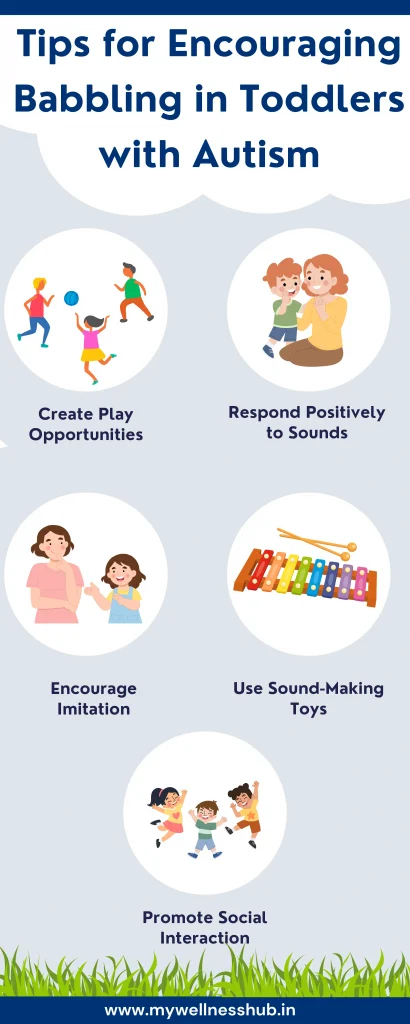
Encouraging Socially Directed Babbling
When it comes to supporting toddlers with autism in babbling, the goal is to make their vocalizations more socially directed. Here are some key elements that can help guide parents:
- Importance of Eye Gaze, Gestures, and Meaningful Social-Communication Exchanges:
- Eye Gaze: Encourage eye contact by positioning yourself at your child’s eye level while playing.
- Gestures: Teach simple gestures like pointing, waving, and clapping, which are essential precursors to language.
- Social-Communication Exchanges: Create moments where your child engages in turn-taking activities like peek-a-boo, which helps them understand social interaction.
- Tips for Parents to Encourage Babbling and Interaction:
- Play Opportunities with Repetitive Games:
- Play repetitive games like peek-a-boo and pat-a-cake to engage your child’s attention and encourage vocal play.
- Use sound-making toys (e.g., rattles and musical instruments) to make playtime more engaging.
- Encouraging Imitation of Mouth and Hand Movements:
- Make exaggerated mouth movements when pronouncing simple syllables like ‘ba,’ ‘ma,’ and ‘da’ to help your child imitate them.
- Use finger-play games like “Itsy Bitsy Spider” to help them imitate hand movements.
- Responding Positively to Any Sound-Making:
- Respond enthusiastically to any sound your child makes, including grunts, cooing, and squeals, to reinforce vocal play.
- Expand on their vocalizations by repeating their sounds and adding new syllables.
- Play Opportunities with Repetitive Games:
Know more: Boost Your Toddler’s Speech with These Proven 6 Tips
Conclusion
Early detection and intervention are crucial for supporting toddlers with autism in their speech and language development. Monitoring babbling patterns and milestones can help identify early signs of autism, allowing parents to seek timely help. By encouraging socially directed babbling and creating fun play environments, parents can support their child’s communication skills.
At Wellness Hub, we understand the challenges families face when navigating autism. Our speech therapy services are designed to empower children with autism and support their families every step of the way. Whether you’re looking for answers or ready to start your child’s therapy journey, our experts are here to help. Let’s ensure that every child has the opportunity to communicate confidently and reach their full potential.
Frequently Asked Questions:
1. Do Toddlers with Autism Babble Like Other Kids?
Toddlers with autism often babble differently than neurotypical children. They may start babbling later, babble less frequently, or produce repetitive strings of nonsensical sounds called jargon. However, every child is unique, and some toddlers with autism may babble similarly to their neurotypical peers.
2. Is Babbling an Early Sign of Autism in Toddlers?
Yes, reduced or delayed babbling can be an early sign of autism. If a child isn’t babbling by 12 months or shows little interest in social interaction, it’s essential to consult a speech-language pathologist or pediatrician.
3. How Does Babbling Differ in Toddlers with Autism?
Babbling in toddlers with autism can differ in several ways:
- Delayed Onset: They may start babbling later than neurotypical children.
- Reduced Frequency: They might not babble as often.
- Lack of Social Engagement: Babbling may not be directed toward others.
- Jargon: They may produce repetitive, nonsensical sounds.
4. What Are Babbling Milestones for Toddlers with Autism?
Milestones to watch for include:
- Canonical babbling (repeating syllables like ‘dada’) by around 10 months.
- Making eye contact or using gestures while babbling.
- Using a mix of sounds and syllables by 18 months.
5. How Can Parents Encourage Babbling in Toddlers with Autism?
Parents can encourage babbling by:
- Engaging in repetitive games like peek-a-boo.
- Responding positively to any sound-making (grunts, cooing, squeals, etc.).
- Encouraging gestures like waving and pointing.
- Creating a playful environment with sound-making toys.
6. How Does Speech Therapy Help Toddlers with Autism Babble More?
Speech therapy helps by:
- Providing strategies to encourage vocalization.
- Working on interactive play to foster social communication.
- Setting achievable goals to improve speech development.
- Using assistive communication devices if necessary.
7. When Should Parents Seek Professional Help for Delayed Babbling?
If a child isn’t babbling by 12 months or shows reduced social engagement, parents should consult a speech therapist or pediatrician for an evaluation.
8. Where Can I Find Support for Speech Development in Toddlers with Autism?
Wellness Hub offers specialized speech therapy services to support toddlers with autism in reaching their communication milestones. Consult our experts for personalized advice and guidance.
9. Can Nonverbal Toddlers with Autism Learn to Speak Through Babbling?
Yes, many nonverbal toddlers with autism can learn to speak. Research indicates that nonverbal children who show strong social engagement and receive early intervention are more likely to develop spoken language. Speech therapy can help encourage socially directed babbling, which is often a precursor to meaningful speech.
10. What Role Does Play Have in Encouraging Babbling in Toddlers with Autism?
Play plays a significant role in encouraging babbling because it creates a fun and relaxed environment where toddlers feel safe to experiment with sounds. Games like peek-a-boo, pat-a-cake, and musical toys can help them vocalize, while interactive play fosters social engagement and meaningful communication.
About the Author:
Rajini Darugupally
M.Sc., Speech-Language Pathologist (9+ years of experience)
Rajini is a passionate and dedicated Speech-Language Pathologist with over 9+ years of experience, specializing in both developmental speech and language disorders in children and rehabilitation in adults. Driven by a desire to empower each individual to find their voice, Rajini brings a wealth of experience and a warm, genuine approach to therapy.
Currently, at Wellness Hub, she thrives in a team environment that values innovation, compassion, and achieving results for their clients.
Connect with Rajini to learn more about how she can help you or your loved one find their voice.
Book your Free Consultation Today
Parent/Caregiver Info:
Client’s Details:
* Error Message

